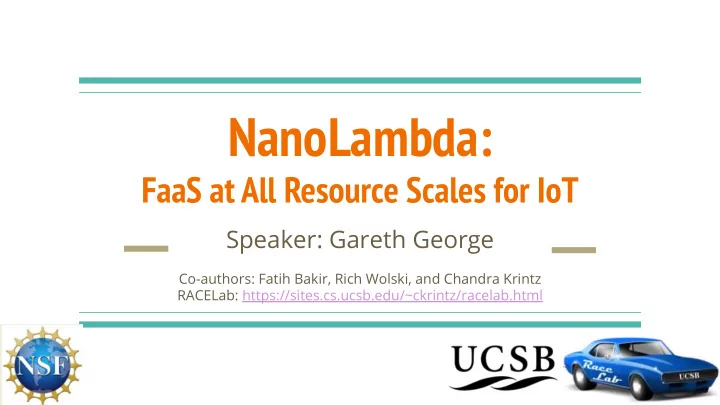

NanoLambda: FaaS at All Resource Scales for IoT Speaker: Gareth George Co-authors: Fatih Bakir, Rich Wolski, and Chandra Krintz RACELab: https://sites.cs.ucsb.edu/~ckrintz/racelab.html
Background IoT devices are increasingly prevalent producers of data ● Programming & processing data remains a challenge ● On device processing: ○ Often difficult to implement ■ Portability, security, maintainability all are challenges ■ Cloud / Edge Cloud processing ○ Easy to program in high level languages ■ Tools such as FaaS provide a homogenous and scalable execution environment ■ Cloud introduces expensive network cost and latency ■ IoT devices will produce 80 zettabytes a year (*IDC) by 2025 ● *IDC market analysis firm on IoT data https://www.idc.com/getdoc.jsp?containerId=prUS45213219
Background What if we could bring FaaS to the device? The challenge is that FaaS is currently limited to the Cloud or Edge* Data must be moved from device to data center ● High power cost for low power devices to transmit over WiFi ● Poor network infrastructure in rural areas ● Existing FaaS runtimes are limited to Linux-based edge systems ● *AWS GreenGrass and similar services
Introducing NanoLambda NanoLambda: platform for running FaaS handlers across all tiers ● On Device ○ Cloud / Edge ○ Compatible with AWS Lambda ○ Goals ● Ease of development ○ Portability ○ Small code and memory footprint ESP8266 development board ○ Security ○ Uniform programming methodology ○ At the smallest scales ● ESP8266 with 96KB of ram and 512KB of program flash storage ○ CC3220SF with 256KB of ram and 1MB of program flash storage ○
Deploying FaaS Functions
NanoLambda Architecture
NanoLambda Architecture Comprised of two core systems NanoLambda Cloud/Edge ● FaaS handler registry & edge execution environment ○ Remote code compilation and bytecode delivery to IoT devices ○ NanoLambda On Device ● Provides on-device handler execution capabilities with IoTPy ○ Leverages Python VM isolation to provide isolation ○
IoTPy Design Why python? ● Why not an existing interpreter like micropython? ● Lacks key embedding features ○ Binary size - micropython 620KB binary vs IoTPy 290KB binary ○ IoTPy features ● Lean memory footprint by leveraging NanoLambda Cloud/Edge for bytecode generation ○ Object-oriented VM implementation & first class embedding support ○ IoTPy provides a C/C++ interface for native extensions / functions ● Built in libraries include: math, json, device, and interaction with NanoLambda ○ Cloud/Edge’s Lambda service Security ● Python VM provides memory protection and container-like isolation ○
NanoLambda Cloud/Edge Service provides two REST API servers offering ● Persistent object storage compatible with S3 ○ A FaaS service that deploys functions written for AWS Lambda ○ Built with CSPOT -- a low level framework providing FaaS primitives ● S3 is implemented as a layer on top CSPOT’s append only object storage ○ Lambda is implemented with event handlers triggered by invocation log updates ○ Handlers are run in Linux containers allowing for concurrent but isolated execution ○ Provides a registry of function definitions stored in S3 service ● Binary API for fetching compiled function bytecode ●
NanoLambda On Device Runs python handlers on non-Linux IoT devices ● Much like NanoLambda Cloud/Edge, invocations triggered by log events ● Events can originate from sensors on device ○ Data can also be delivered remotely over CSPOT’s network ○ Each append runs a C-language handler function invoking IoTPy ● On cold start function bytecode is requested from NanoLambda Cloud/Edge ○ IoTPy caches bytecode & interpreter state to accelerate future runs ○
Execution Offloading NanoLambda On Device is code compatible with NanoLambda Cloud/Edge On Device supports devices as small as ESP8266 and the CC3220SF ● NanoLambda Cloud/Edge runs on Linux at the edge and in the cloud ● Portability: The choice to use NanoLambda allows for On Device, at the Edge, in the private Cloud, or directly on AWS Lambda
Predictive Maintenance Application Predictive Maintenance is a technique using sensors to detect part failure ● We examine failure detection in motors using accelerometers ● Setup: ● Accelerometer attached to a motor reads vibration magnitude 5 times a second ○ Data is appended to a WooF for persistence, a history of 32 records is kept. ○ Each append triggers failure detection handler to run ○ Handler is benchmarked running on NanoLambda On Device and ● NanoLambda Cloud/Edge for various problem sizes and configurations
Predictive Maintenance Application
Plotting Power & Invocation Latency
Naive Offloading Scheduler Naive algorithm: Pick the lowest latency (time to result) ● execution strategy based on history Local (On Device) or Remote ○ (Cloud) Every 16 invocations reset the history to ● allow model to recover from network spikes
Naive Offloading Scheduler Power
Concluding Remarks NanoLambda Contributions: Power & Latency Savings ● Ease of development ● Reprogrammability ● Portability ● Security ●
Thank you! Authors: Gareth George (Presentor), Fatih Bakir, Rich Wolski, Chandra Krintz Contact: gareth@ucsb.edu 'Graphics: Flaticon.com'. This presentation has been designed using resources from Flaticon.com
Recommend
More recommend